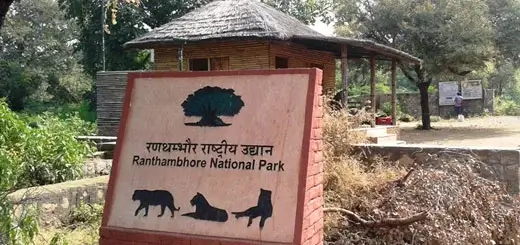
The most notable wildlife reserve in Northern India, Ranthambore National Park is located in the Sawai Madhopur district of Rajasthan, which is almost about 130 kilometers away from the capital city Jaipur. The wildlife reserve is being considered as one of the most renowned and former hunting areas of the Kings/ Maharajas of Jaipur, till date this National Park terrain is a major wildlife tourist attraction spot that has drawn a major attention of various wildlife photographers and wildlife enthusiasts. It is also counted as the famous heritage site and the reason behind this is of the symbolic carcass that marks the wildlife park.
Wildlife species at the national park
The national park is spread over an area of approximately 392 sq kilometers and it is a home of various fauna species that you can spot during your Jungle Safari in Ranthambore. You can spot Royal Bengal Tiger, Leopards, Striped Hyenas, Chital, Nilgai, Sambar Deer, Black Bucks, Common or Hanuman Langurs, Macaques, Jackals, Jungle cats, Caracals, Sloth Bear, Rufoustailed Hare, Indian Wild Boar, Chinkara, Common Yellow Bats, Desert Cats, Fivestriped palm squirrels, Indian False Vampires, Indian Flying Foxes, Indian Gerabillies, and many others. The amphibian species of the national park consists of Common India Toad and the Common Frog.
There are many accommodation options are available in Ranthambore such as homestays, hotels, resorts etc. To figure out the bountiful beauty of Ranthambore, refreshing weather, lavish green surroundings, well-maintained heritage sites makes Maa Ashapura Farm a Best Resort in Ranthambore. Being a perfect get-away location, this resort gains a complacent leisure and spending quality time.
Popular places in and around the royal prefecture
Ranthambore is not only famous for its Ranthambore National Park, but it is also an abode of distinct heritage sites to visit in and around the wildlife reserve such as-
Ranthambore Fort
the world heritage site, Ranthambore Fort exhibits the unimpeachable laudation of the Chauhan Dynasty.
Trinetra Ganesh Temple
the name itself depicts the temple is dedicated to “Three-Eyed Ganesh Temple” which is comprised of Ganesha’s whole family.
Padam Talao Lake
an artificial Padam Talao lake is the largest lake which is another halt inside the park entrenched with the splendor of Jogi Mahal.
Malik Talao
snuggle amidst the massive green forest, Malik Talao is a heavenly place for capturing migratory birds and crocodiles.
Raj Bagh Talao
the beautiful and most attractive lake in the national park is a tiger descrying area and you can also spot Sambhar Deer at the lake.
Jeep Safari
the most desirable way to explore wildlife especially for wildlife photography is Jeep Safari. While exploring jeep safari there is a high chance to preview sambhar deer, tigers, leopard, sloth bear, langur, and blue bull.
Kachida Valley
a treasure trove of a variety of plants, migratory birds, insects, endangered animals etc.
Rajiv Gandhi Regional Museum
amongst the 4th regional museum that spreads an awareness for the significance of preserving flora & fauna species.
Best time to explore Ranthambore National Park
The national park remains closed during the monsoon season and during summers there are lesser chance to spot the enriched wildlife species. Thus it is advisable to explore the National Park in the winter season between the months of October to March.
At last, after knowing such wonderful information about the Ranthambore National Park, animals you can spot in the wildlife reserves, places to visit in and around the national park, you can easily plan your weekend or holidays as a wildlife tour to Ranthambore to cherish the richness and charisma of the best Ranthambore resorts which not only offers you self-reliant tented abode but also, bestow a noteworthy sense of timelessness in the Motherland, bejeweled with remains of heritage forts & daring takeovers of animal kingdom.